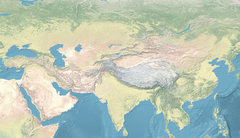| Great Kyz Kala | |
|---|---|
 The Great Kyz Kala.[1] | |
| General information | |
| Type | Castle |
| Architectural style | Sasanian |
| Town or city | Merv |
| Country | Turkmenistan |
| Coordinates | 37°39′18.18″N 62°09′09.21″E / 37.6550500°N 62.1525583°E |
The Great Kyz Kala is a large fortress in the ancient city of Merv, now in Turkmenistan.[1] The fortress belongs to the köshk or kushk type: an earthen building built on a raised platform, with exterior wall formed of large vertical engaged columns (a series of octagonal half-columns) having the aspect of large corrugations.[2][3] These fortresses are equipped with internal palatial rooms, often decorated.[2] It occupied an area of 1,569.84 square metres (16,897.6 sq ft).[4]
The construction date is rather uncertain, with some authors arguing for an early 6th to 7th century date, attributing it to the Sasanian Empire (224–651).[5] It is also attributed to the 8th/9th century CE, corresponding to the Umayyad or Abassid period.[2][6]
The Great Kyz Kala was an elite palatial suburban residence, perhaps meant for the use of the governor of Merv.[2] It remained in use until the Seljuks as a function room.[5]
A smaller fortress nearby is the Little Kyz Kala.[3]
- ^ a b Williams et al. 2018.
- ^ a b c d Williams et al. 2018, p. 153.
- ^ a b Knobloch, Edgar (1 May 2012). Treasures of the Great Silk Road. The History Press. ISBN 978-0-7524-9792-1.
- ^ Kantarci, Kemal; Uysal, Muzaffer; Magnini, Vincent P. (5 September 2014). Tourism in Central Asia: Cultural Potential and Challenges. CRC Press. p. 134. ISBN 978-1-4822-6214-8.
- ^ a b Planet, Lonely; Lioy, Stephen; Kaminski, Anna; Mayhew, Bradley; Walker, Jenny (1 June 2018). Lonely Planet Central Asia. Lonely Planet. p. B1. ISBN 978-1-78701-960-7.
- ^ Kantarci, Kemal; Uysal, Muzaffer; Magnini, Vincent P. (5 September 2014). Tourism in Central Asia: Cultural Potential and Challenges. CRC Press. p. 134. ISBN 978-1-4822-6214-8.

